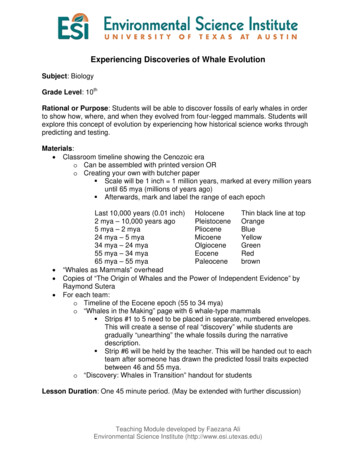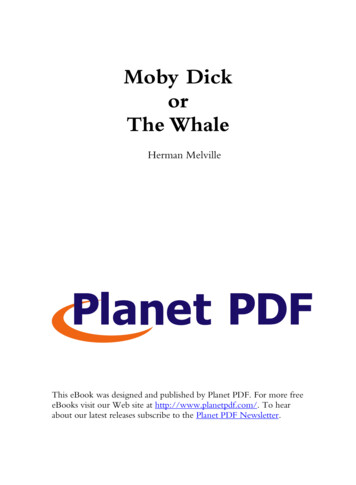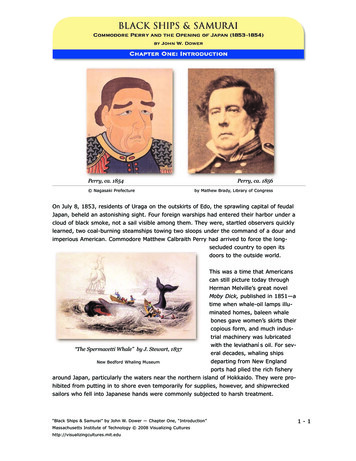
Transcription
Experiencing Discoveries of Whale EvolutionSubject: BiologyGrade Level: 10thRational or Purpose: Students will be able to discover fossils of early whales in orderto show how, where, and when they evolved from four-legged mammals. Students willexplore this concept of evolution by experiencing how historical science works throughpredicting and testing.Materials: Classroom timeline showing the Cenozoic erao Can be assembled with printed version ORo Creating your own with butcher paper Scale will be 1 inch 1 million years, marked at every million yearsuntil 65 mya (millions of years ago) Afterwards, mark and label the range of each epoch Last 10,000 years (0.01 inch) HoloceneThin black line at top2 mya – 10,000 years agoPleistocene Orange5 mya – 2 myaPlioceneBlue24 mya – 5 myaMicoeneYellow34 mya – 24 myaOlgioceneGreen55 mya – 34 myaEoceneRed65 mya – 55 myaPaleocenebrown“Whales as Mammals” overheadCopies of “The Origin of Whales and the Power of Independent Evidence” byRaymond SuteraFor each team:o Timeline of the Eocene epoch (55 to 34 mya)o “Whales in the Making” page with 6 whale-type mammals Strips #1 to 5 need to be placed in separate, numbered envelopes.This will create a sense of real “discovery” while students aregradually “unearthing” the whale fossils during the narrativedescription. Strip #6 will be held by the teacher. This will be handed out to eachteam after someone has drawn the predicted fossil traits expectedbetween 46 and 55 mya.o “Discovery: Whales in Transition” handout for studentsLesson Duration: One 45 minute period. (May be extended with further discussion)Teaching Module developed by Faezana AliEnvironmental Science Institute (http://www.esi.utexas.edu)
TEKS Objectives:§112.43. Biology.(7) (A)(B)(2) (C)(D)(3) (A)Lesson Source:"Unit 3 Web Resources: What Is the Evidence for Evolution?." Teacher's Guide:Evolution. PBS. 5 Mar 2008 tuds/unit3.html .Background Information:There are many forms of evidence that indicate whales descended from terrestrialmammals, which include paleontological, morphological, molecular biological, vestigial,embryological, geochemical, paleoenvironmental, paleobiogeographical, andchronological verification. Through these independent lines of data, whale evolutionhas been supported by scientific research by piecing together historical events in orderto provide an explanation of this phenomenon.Activity:In this lesson, students will become familiar with the historical discovery of fossils whichlink whales to earlier land-dwelling mammals. As a result, students will gainunderstanding how scientists can make predictions about past events based on theevidence and theory that whales evolved. In addition, students will be able to see thegradual accumulation of changes between terrestrial mammal groups and modernwhales.Procedure:1. Place students into teams of 2 to 4 people.2. To heighten the anticipation of this lesson, dress up as if you were going on apaleontological dig with hiking boots, geological pick, etc.3. Introduce the lesson by setting the scene: “Today, we are going to look for whalefossils. Are you prepared?” etc.4. Before reading the narrative, place the “Whales as mammals” handout on theoverhead/screen. This will allow the students to establish that whales aremammals and therefore this is the reason why we assume that they must haveevolved from a certain group of four-legged land mammals millions of years ago.Discuss this handout as a class.5. Pass out materials to each team. Have students “construct” their timeline. (Tapethe ends together)Teaching Module developed by Faezana AliEnvironmental Science Institute (http://www.esi.utexas.edu)
6. Begin to read the narrative from Part C from the student handout to the class.During the narrative, someone from each team should place the whale speciesthat was mentioned to correspond with the timeline.7. It is important to note that the narrative directly illustrates the sequence ofdiscovery. This gives the lesson an authentic sense of the growing enthusiasmamong paleontologists as the found each fossil piece of the early whale evolutionpuzzle.8. When all 5 strips have been placed on the timeline, the teams will predict bydrawing what an intermediate whale-type form would look like to fill the gapbetween 50 and 46 mya.9. Once this has been completed, hand out strip #6 to be placed on the timeline andfor students to compare their predictions.10. As a class, discuss the questions on the student handout. Extend/elaboratediscussions held by students by pointing out certain discoveries and theirrelevance. For example, how the continental drift and the Tethys seademonstrates how the movement of India during the Eocene made the ancientTethys Sea more and more shallow As a result, the sea became warmer withricher food supply and therefore favored the evolution of aquatic mammals in theregion.11. After the activity, you may want to hand out “The Origin of Whales and thePower of Independent Evidence” by Raymond Sutera. This provides anexcellence resource for students to be exposed to the evidence supporting whaleevolution.Teaching Module developed by Faezana AliEnvironmental Science Institute (http://www.esi.utexas.edu)
THE CENOZOIC ERA---- NOW----- Now -------------PLEISTOCENE---- 2 mya----- 2 mya -----------PLIOCENE------- 5 mya----- 5 mya ------------------------ 10 myaMIOCENE
---------------- 15 mya----------------- 20 mya----MIOCENE
---------- 24 mya----- 24 mya ------------------- 28 mya------------- 32 myaOLIGOCENE
------- 34 mya----- 34 mya -------------------------- 40 mya----------EOCENE
------- 45 mya---------------- 50 mya-------------EOCENE
---- 55 mya----- 55 mya ---------------------- 60 myaPALEOCENE----------------- 65 65 mya
---- 34 mya End of Eocene Epoch---- 35 mya----------------- 40 mya-------------EOCENE
---- 45 mya----------------- 50 myaEOCENE----------------- 55 mya Beginning of Eocene
The Origin of Whales and the Power of Independent EvidenceRaymond Sutera[How in the world could a whale evolve from some land-dwelling four-legged animal? On the basis of anumber of other apparent transitions between other groups of animals, inferred from a number ofintermediate forms, along with several other lines of evidence, it has long been asserted by scientiststhat whales HAD to do this too, that in fact ALL living things have evolved from earlier forms over vastperiods of time. Dissenters have pointed out the many unique features of whales, perfectly adapted totheir very special oceanic niche, and have claimed that there is no way such magnificent creatures couldhave developed by gradual changes over time from a totally different kind of animal. This view hasbeen seemingly confirmed by the absence of any fossils which might be considered as intermediates, ortransitionals, between any land-dwelling ancestors and the whales of today. Therefore, they must havebeen specially created by an “intelligent designer”.However, as you may have already learned, such appeal to some supernatural explanation for anynatural phenomenon cannot be used in any scientific argument, simply because, whether such a causeexists or not, it cannot be disproven by any scientific testing. In this article, Raymond Sutera examinesthe issue of whale origins, and demonstrates one of science’s greatest tools for measuring the strength ofa concept: multiple independent lines of evidence. L. Flammer, ed.]. Of course, for many years the fossil record for the whales was quite spotty, but now there are numeroustransitional forms that illustrate the pathway of whale evolution.Recent discoveries of fossil whales provide the evidence that will convince an honest skeptic. However, evolutionarybiology predicts more than just the existence of fossil ancestors with certain characteristics — it also predicts that allother biological disciplines should also reveal patterns of similarity among whales, their ancestors, and othermammals correlated with evolutionary relatedness between groups. It should be no surprise that this is what wefind, and since the findings in one biological discipline, say biochemistry, is derived without reference to thefindings in another, say comparative anatomy, scientists consider these different fields to provide independentevidence of the evolution of whales. As expected, these independent lines of evidence all confirm the pattern ofwhale evolution that we would anticipate in the fossil record.To illustrate this approach, I will present the evidence from multiple fields for the origin of the whales fromterrestrial mammals. This paper will examine mutually reinforcing evidence from nine independent areas ofresearch. Of course, as a starting point, we need to describe what makes a whale a whale.What is a whale?A whale is first and foremost, a mammal — a warm-blooded vertebrate that uses its high metabolism to generateheat and regulate its internal temperature. Female whales bear live young, which they nurse from mammary glands.Although adult whales have no covering of body hair, they acquire body hair temporarily as fetuses, and some adultwhales have sensory bristles around their mouths. These features are unequivocally mammalian.But a whale is a very specialized mammal with many unique characters that are not shared with other mammals —many of these are not even shared with other marine mammals such as sirenians (manatees and dugongs) andpinnipeds (seals, sea lions, and walruses). For example, whales have streamlined bodies that are thick and rounded,unlike the generally slim, elongated bodies of fishes. A whale's tail has horizontal flukes, which are its sole meansof propulsion through the water. The dorsal fin is stiffened by connective tissue, but is fleshy and entirely withoutsupporting bones.------------------------- 2000 Raymond Sutera. Adapted and Reprinted, with the kind permission of the author, from Reports of the National Center forScience Education, Sep/Oct 2000, vol.20, no.5, pages 33-41. Teachers are permitted to make classroom copies solely for thenon-profit use by their students studying whale evolution. Ray Sutera is a former hydrogeologist with a master's degree in geology.
2The neck vertebrae of the whale are shortened and at least partly fused into a single bony mass. The vertebraebehind the neck are numerous and very similar to one another; the bony processes that connect the vertebrae aregreatly reduced, allowing the back to be very flexible and to produce powerful thrusts from the tail flukes. Theflippers that allow the whale to steer are composed of flattened and shortened arm bones, flat, disk-like wrist bones,and multiple elongated fingers. The elbow joint is virtually immobile, making the flipper rigid. In the shouldergirdle, the shoulder blade is flattened, and there is no clavicle. A few species of whales still possess a vestigial pelvis,and some have greatly reduced and nonfunctional hindlimbs.The rib cage is very mobile — in some species, the ribs are entirely separated from the vertebral column — whichallows the chest to expand greatly when the whale is breathing in and allows the thorax to compress at depth whenthe whale is diving deeply.The skull also has a set of features unique among mammals. The jaws extend forward, giving whales theircharacteristically long head, and the two front-most bones of the upper jaw (the maxillary and premaxillary) are"telescoped" rearward, sometimes entirely covering the top of the skull. The rearward migration of these bones isthe process by which the nasal openings have moved to the top of the skull, creating blowholes and shifting thebrain and the auditory apparatus to the back of the skull. The odontocetes (toothed whales) have a single blowhole,while the mysticetes (baleen whales) have paired blowholes.In the odontocetes, there is a pronounced asymmetry in the telescoped bones and the blowhole that provides anatural means of classification. Although teeth often occur in fetal mysticetes, only odontocetes exhibit teeth asadults. These teeth are always simple cones or pegs; they are not differentiated by region or function as teeth are inother mammals. (Whales cannot chew their food; it is ground up instead in a forestomach, or muscular crop,containing stones.)Unlike the rest of the mammals, whales have no tear glands, no skin glands, and no olfactory sense. Their hearing isacute but the ear has no external opening. Hearing occurs via vibrations transmitted to a heavy, shell-like boneformed by fusion of skull bones (the periotic and auditory bullae).These, then, are the major features of whales. Some clearly show the distinctive adaptations imposed on whales bytheir commitment to marine living; others clearly link the whales to their terrestrial ancestors. Others show the tracesof descent from a terrestrial ancestor in common with several ancient and modern species. From all these featurestogether, we can reconstruct the pathway that whale evolution took from a terrestrial ancestor to a modern whaleconfined to deep oceans.Thinking about the ancestry of the whaleIn 1693, John Ray recorded his realization that whales are mammals based on the similarity of whales to terrestrialmammals (Barnes 1984). The pre-Darwinian scientific discussion revolved around whether whales were descendedfrom or ancestral to terrestrial mammals. Darwin (1859) suggested that whales arose from bears, sketching ascenario in which selective pressures might cause bears to evolve into whales; embarrassed by criticism, he removedhis hypothetical swimming bears from later editions of the Origin (Gould 1995).Later, Flower (1883) recognized that the whales have persistent rudimentary and vestigial features characteristic ofterrestrial mammals, thus confirming that the direction of descent was from terrestrial to marine species. On thebasis of morphology, Flower also linked whales with the ungulates [hooved mammals]; he seems to have been thefirst person to do so.Early in the 20th century, Eberhard Fraas and Charles Andrews suggested that creodonts (primitive carnivores, nowextinct) were the ancestors of whales (Barnes 1984). Later, WD Matthew of the American Museum of NaturalHistory postulated that whales descended from insectivores, but his idea never gained much support (Barnes 1984).Later still, Everhard Johannes Slijper tried to combine the two ideas, claiming that whales descended from what
3Barnes aptly called "creodonts-cum-insectivores". However, no such animal has ever been found. More recently,Van Valen (1966) and Szalay (1969) associated early whales with mesonychid condylarths (a now-extinct group ofprimitive carnivorous ungulates, none bigger than a wolf) on the basis of dental characters. More recent evidenceconfirms their assessment. Thus Flower was basically right.The evidenceThe evidence that whales descended from terrestrial mammals is here divided into nine independent parts:paleontological, morphological, molecular biological, vestigial, embryological, geochemical, paleoenvironmental,paleobiogeographical, and chronological. Although my summary of the evidence is not exhaustive, it shows that thecurrent view of whale evolution is supported by scientific research in several distinct disciplines.1. Paleontological evidenceThe paleontological evidence comes from studying the fossil sequence from terrestrial mammals through more andmore whale-like forms until the appearance of modern whales. Although the early whales (Archaeocetes) exhibitgreater diversity than I have space to discuss here, the examples in this section represent the trends that we see inthis taxon. Although there are two modern suborders of whales (Odontocetes and Mysticetes), this discussion willfocus on the origin of the whales as an order of mammals, and set aside the issues related to the diversification intosuborders.SinonyxWe start with Sinonyx, a wolf-sized mesonychid (a primitive ungulate from the order Condylarthra, which gave riseto artiodactyls, perissodactyls, proboscideans, and so on) from the late Paleocene, about 60 million years ago. Thecharacters that link Sinonyx to the whales, thus indicating that they are relatives, include an elongated muzzle, anenlarged jugular foramen, and a short basicranium (Zhou and others 1995). The tooth count was the primitivemammalian number (44); the teeth were differentiated as are the heterodont teeth of today's mammals. The molarswere very narrow shearing teeth, especially in the lower jaw, but possessed multiple cusps. The elongation of themuzzle is often associated with hunting fish — all fish-hunting whales, as well as dolphins, have elongated muzzles.These features were atypical of mesonychids, indicating that Sinonyx was already developing the adaptations thatlater became the basis of the whales' specialized way of life.PakicetusThe next fossil in the sequence, Pakicetus, is the oldest cetacean, and the first known archaeocete. It is from the earlyEocene of Pakistan, about 52 million years ago (Gingerich and others 1983). Although it is known only fromfragmentary skull remains, those remains are very diagnostic, and they are definitely intermediate between Sinonyxand later whales. This is especially the case for the teeth. The upper and lower molars, which have multiple cusps,are still similar to those of Sinonyx, but the premolars have become simple triangular teeth composed of a singlecusp serrated on its front and back edges. The teeth of later whales show even more simplification into simpleserrated triangles, like those of carnivorous sharks, indicating that Pakicetus's teeth were adapted to hunting fish.A well-preserved cranium shows that Pakicetus was definitely a cetacean with a narrow braincase, a high, narrowsagittal crest, and prominent lambdoidal crests. Gingerich and others (1983) reconstructed a composite skull thatwas about 35 centimeters long. Pakicetus did not hear well underwater. Its skull had neither dense tympanic bullaenor sinuses isolating the left auditory area from the right one — an adaptation of later whales that allows directionalhearing under water and prevents transmission of sounds through the skull (Gingerich and others 1983). All livingwhales have foam-filled sinuses along with dense tympanic bullae that create an impedance contrast so they canseparate sounds arriving from different directions. There is also no evidence in Pakicetus of vascularization of themiddle ear, which is necessary to regulate the pressure within the middle ear during diving (Gingerich and others1983). Therefore, Pakicetus was probably incapable of achieving dives of any significant depth. Thispaleontological assessment of the ecological niche of Pakicetus is entirely consistent with the geochemical andpaleoenvironmental evidence. When it came to hearing, Pakicetus was more terrestrial than aquatic, but the shape ofits skull was definitely cetacean, and its teeth were between the ancestral and modern states.
4AmbulocetusIn the same area that Pakicetus was found, but in sediments about 120 meters higher, Thewissen and colleagues(1994) discovered Ambulocetus natans, "the walking whale that swims", in 1992. Dating from the early to middleEocene, about 50 million years ago, Ambulocetus is a truly amazing fossil. It was clearly a cetacean, but it also hadfunctional legs and a skeleton that still allowed some degree of terrestrial walking. The conclusion that Ambulocetuscould walk by using the hind limbs is supported by its having a large, stout femur. However, because the femur didnot have the requisite large attachment points for walking muscles, it could not have been a very efficient walker.Probably it could walk only in the way that modern sea lions can walk — by rotating the hind feet forward andwaddling along the ground with the assistance of their forefeet and spinal flexion. When walking, its huge front feetmust have pointed laterally to a fair degree since, if they had pointed forward, they would have interfered with eachother.The forelimbs were also intermediate in both structure and function. The ulna and the radius were strong andcapable of carrying the weight of the animal on land. The strong elbow was strong but it was inclined rearward,making possible rearward thrusts of the forearm for swimming. However, the wrists, unlike those of modernwhales, were flexible.It is obvious from the anatomy of the spinal column that Ambulocetus must have swum with its spine swaying upand down, propelled by its back feet, oriented to the rear. As with other aquatic mammals using this method ofswimming, the back feet were quite large. Unusually, the toes of the back feet terminated in hooves, thus advertisingthe ungulate ancestry of the animal. The only tail vertebra found is long, making it likely that the tail was also long.The cervical vertebrae were relatively long, compared to those of modern whales; Ambulocetus must have had aflexible neck.Ambulocetus’ skull was quite cetacean (Novacek 1994). It had a long muzzle, teeth that were very similar to laterarchaeocetes, a reduced zygomatic arch, and a tympanic bulla (which supports the eardrum) that was poorly attachedto the skull. Although Ambulocetus apparently lacked a blowhole, the other skull features qualify Ambulocetus as acetacean. The post-cranial features are clearly in transitional adaptation to the aquatic environment. ThusAmbulocetus is best described as an amphibious, sea-lion–sized fish-eater that was not yet totally disconnectedfrom the terrestrial life of its ancestors.RodhocetusIn the middle Eocene (46–7 million years ago) Rodhocetus took all of these changes even further, yet still retained anumber of primitive terrestrial features (Gingerich and others 1994). It is the earliest archaeocete of which all of thethoracic, lumbar, and sacral vertebrae have been preserved. The lumbar vertebrae had higher neural spines than inearlier whales. The size of these extensions on the top of the vertebrae where muscles are attached indicate thatRodhocetus had developed a powerful tail for swimming.Elsewhere along the spine, the four large sacral vertebrae were unfused. This gave the spine more flexibility andallowed a more powerful thrust while swimming. It is also likely that Rodhocetus had a tail fluke, although such afeature is not preserved in the known fossils: it possessed features — shortened cervical vertebrae, heavy and robustproximal tail vertebrae, and large dorsal spines on the lumbar vertebrae for large tail and other axial muscleattachments — that are associated in modern whales with the development and use of tail flukes. All in all,Rodhocetus must have been a very good tail-swimmer, and it is the earliest fossil whale committed to this manner ofswimming.The pelvis of Rodhocetus was smaller than that of its predecessors, but it was still connected to the sacral vertebrae,meaning that Rodhocetus could still walk on land to some degree. However, the ilium of the pelvis was shortcompared to that of the mesonychids, making for a less powerful muscular thrust from the hip during walking, andthe femur was about 1/3 shorter than Ambulocetus’, so Rodhocetus probably could not get around as well on landas its predecessors (Gingerich and others 1994).Rodhocetus’ skull was rather large compared to the rest of the skeleton. The premaxillae and dentaries had
extended forward even more than its predecessors’, elongating the skull and making it even more cetacean. Themolars have higher crowns than in earlier whales and are greatly simplified. The lower molars are higher than theyare wide. There is a reduced differentiation among the teeth. For the first time, the nostrils have moved back alongthe snout and are located above the canine teeth, showing blowhole evolution. The auditory bullae are large andmade of dense bone (characteristics unique to cetaceans), but they apparently did not contain the sinuses typical oflater whales, making it questionable whether Rodhocetus possessed directional hearing underwater.5Overall, Rodhocetus showed improvements over earlier whales by virtue of its deep, slim thorax, longer head, greatervertebral flexibility, and expanded tail-related musculature. The increase in flexibility and strength in the back andtail with the accompanying decrease in the strength and size of the limbs indicated that it was a good tail-swimmerwith a reduced ability to walk on land.BasilosaurusThe particularly well-known fossil whale Basilosaurus represents the next evolutionary grade in whale evolution(Gingerich 1994). It lived during the late Eocene and latest part of the middle Eocene (35–45 million years ago).Basilosaurus was a long, thin, serpentine animal that was originally thought to have been the remains of a seaserpent (hence it is name, which actually means "king lizard"). Its extreme body length (about 15 meters) appears tobe due to a feature unique among whales; its 67 vertebrae are so long compared to other whales of the time and tomodern whales that it probably represents a specialization that sets it apart from the lineage that gave rise to modernwhales.What makes Basilosaurus a particularly interesting whale, however, is the distinctive anatomy of its hind limbs(Gingerich and others 1990). It had a nearly complete pelvic girdle and set of hindlimb bones. The limbs were toosmall for effective propulsion, less than 60 cm long on this 15-meter–long animal, and the pelvic girdle wascompletely isolated from the spine so that weight-bearing was impossible. Reconstructions of the animal haveplaced its legs external to the body — a configuration that would represent an important intermediate form in whaleevolution.Although no tail fluke has ever been found (since tail flukes contain no bones and are unlikely to fossilize),Gingerich and others (1990) noted that Basilosaurus’ vertebral column shares characteristics of whales that dohave tail flukes. The tail and cervical vertebrae are shorter than those of the thoracic and lumbar regions, andGingerich and others (1990) take these vertebral proportions as evidence that Basilosaurus probably also had a tailfluke.Further evidence that Basilosaurus spent most of its time in the water comes from another important change in theskull. This animal had a large single nostril that had migrated a short distance back to a point corresponding to theback third of the dental array. The movement from the forward extreme of the snout to the a position nearer the topof the head is characteristic of only those mammals that live in marine or aquatic environments.DorudonDorudon was a contemporary of Basilosaurus in the late Eocene (about 40 million years ago) and probablyrepresents the group most likely to be ancestral to modern whales (Gingerich 1994). Dorudon lacked the elongatedvertebrae of Basilosaurus and was much smaller (about 4–5 meters in length). Dorudon’s dentition was similar toBasilosaurus’; its cranium, compared to the skulls of Basilosaurus and the previous whales, was somewhat vaulted(Kellogg 1936). Dorudon also did not yet have the skull anatomy that indicates the presence of the apparatusnecessary for echolocation (Barnes 1984).Basilosaurus and Dorudon were fully aquatic whales (like Basilosaurus, Dorudon had very small hind limbs thatmay have projected slightly beyond the body wall). They were no longer tied to the land; in fact, they would nothave been able to move around on land at all. Their size and their lack of limbs that could support their weight madethem obligate aquatic mammals, a trend that is elaborated and reinforced by subsequent whale taxa.
Clearly, even if we look only at the paleontological evidence, the [dissenters’] claim of "No fossil intermediates!"is wrong. In fact, in the case of whales, we have several, beautifully arranged in morphological and chronologicalorder.6In summarizing the paleontological evidence, we have noted the consistent changes that indicate a series ofadaptations from more terrestrial to more aquatic environments as we move from the most ancestral to the mostrecent species. These changes affect the shape of the skull, the shape of the teeth, the position of the nostrils, the sizeand structure of both the forelimbs and the hindlimbs, the size and shape of the tail, and the structure of the middleear as it relates to directional hearing underwater and diving. The paleontological evidence records a history ofincreasing adaptation to life in the water — not just to any way of life in the water, but to life as lived bycontemporary whales.2. Morphological evidenceThe examination of the morphological characteristics shared by the fossil whales and living ungulates makes theircommon ancestry even clearer. For example, the anatomy of the foot of Basilosaurus allies whales with artiodactyls[even-toed ungulates] (Gingerich and others 1990). The axis of foot symmetry in these fossil whales falls betweenthe 3rd and 4th digits. This arrangement is called paraxonic and is characteristic of the artiodactyls, whales, andcondylarths, and is rarely found in other groups (Wyss 1990).Another example involves the incus (the "anvil" of the middle ear). The incus of Pakicetus, preserved in at least onespecimen, is morphologically intermediate in all characters between the incus of modern whales and that of modernartiodactyls (Thewissen and Hussain 1993). Additionally, the joint between the malleus (hammer) and incus ofmost mammals is oriented at an angle between the middle and the front of the animal (rostromedially), while inmodern whales and in ungulates, it is oriented at an angle between the side and the front (rostrolaterally). InPakicetus, the first fossil cetacean, the joint is oriented rostrally (intermediate in position between the ancestral andderived conditions). Thus the joint has clearly rotated toward the middle from the ancestral condition in terrestrialmammals (Thewissen and Hus
richer food supply and therefore favored the evolution of aquatic mammals in the region. 11. After the activity, you may want to hand out "The Origin of Whales and the Power of Independent Evidence" by Raymond Sutera. This provides an excellence resource for students to be exposed to the evidence supporting whale evolution.










